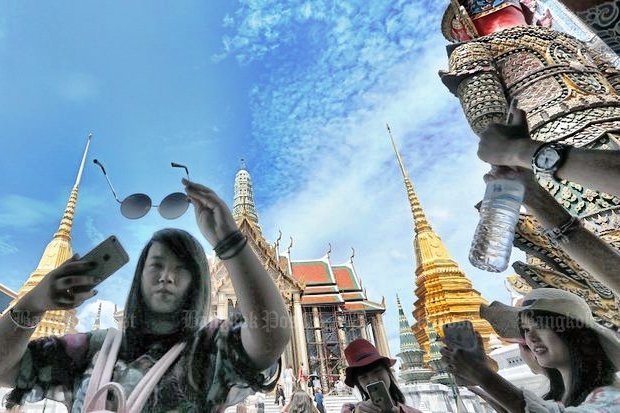
The tourism boom is expected to continue in 2017 and remain a major growth driver for the economy even as the industry sees falling Chinese arrivals in the first few months.
The crackdown on zero-dollar tours in September negatively affected arrivals from China, but authorities and private tourism operators are confident they will gradually return.
The Tourism and Sports Ministry projects tourism revenue in 2017 will reach 2.71 trillion baht, of which 1.78 trillion will come from foreign tourists, growing 8.5% from 2016, and 930 billion will stem from domestic tourists, up 7.5%.
This target has been increased from 2.6 trillion baht forecast earlier, and is 8.2% higher than the 2.5 trillion baht expected in 2016.
The number of international tourists to Thailand is expected to reach 35 million in 2017, up from 32.5 million in 2016.
The country's economic recovery, which has been backed by stimulus measures and massive infrastructure investment, is expected to help drive the growth in Thai tourism. The Fiscal Policy Office predicts the Thai economy will expand by 4% in 2017.
Another supporting factor is more Asean tourists will visit Thailand as the country is an aviation hub in this region, having good connections to both main and secondary cities.
"The expansions at major airports including Don Mueang, Phuket and U-tapao as well as better transportation networks for rail and road will benefit the tourism sector and make tourism more convenient," says Tourism and Sports Minister Kobkarn Wattanavrangkul.
China remains a very important source market for Thai tourism as they represent about 30% of international arrivals. The Tourism Authority of Thailand (TAT) projects Chinese tourist arrivals in 2017 will grow to 9.8 million despite the zero-dollar tour crackdown, up from 8.8 million in 2016. An earlier TAT target was for 10 million Chinese arrivals before the crackdown.
TAT governor Yuthasak Supasorn says the Chinese tourist market has a lot of potential to grow in the future because the Chinese normally make 120 million outbound trips a year.
"The zero-dollar tour crackdown together with economic problems in China are causing adjustments to the tourist market. Chinese arrivals may not skyrocket like in the past, but more quality travellers will visit Thailand in the future," he says.
Some 60% of Chinese tourist arrivals are free independent travellers and 40% come in tour groups. Among the tour group visitors, 50% are lured to Thailand with zero-dollar tour packages.
Even if tour packages to Thailand are priced higher, Mr Yuthasak says Chinese tourists will still pay to visit here because they love Thai food and culture as well as its beautiful nature.
Both the ministry and TAT admit the crackdown affected Chinese tourists arrivals, but believe the impact will be short-lived.
The number of Chinese arrivals fell sharply in October and November, by 16% and 30%, respectively. Travel agents report Chinese tourists are concerned about the unclear situation after the crackdown, with travel agents there suspended from selling packages here.
The Tourism Council of Thailand (TCT) predicts Chinese tourist arrivals will fall by 20%, or 2.1 million, in the first quarter of 2017. But Ms Kobkarn insists the decline in Chinese arrivals is over now, and their numbers will soon return to normal in 2017.
The Thai government is trying to convince the public the crackdown is good for both Thais and Chinese. It wants to prevent Chinese tourists on zero-dollar tours being abandoned on the road and forced to buy expensive goods and services here.
Both sides are working closely to set up a minimum price for tour packages to Thailand that reflects the real cost for tour agents.
The TAT has joined hands with many airlines to promote Thailand. The government also announced measures to boost sentiment by waiving visa fees and reducing visa-on-arrival fees from 2,000 baht to 1,000 baht for many countries including China.
Thai tour agents report travel companies in China started selling tour packages to Thailand again in December. Typically travel companies in China sell packages three months in advance, so Chinese tourists are expected to return to Thailand in pre-crackdown numbers from the second quarter of 2017.
Following the drop in Chinese tourists, the TAT is trying to reduce its dependence on this market. It plans to target Asean, Russia, India and the Middle East to compensate for the decline in Chinese arrivals. The agency also wants to draw luxury tourists to Thailand, including Mice travellers.
The TAT believes Russian tourists will come back in 2017. It plans to negotiate with some airlines to open new routes to more cities in Russia from Thailand.
TCT president Ittirit Kinglek says the European and US markets have good potential for long-stay travellers, and both have average growth of 6-9% per year. Tourists from both continents will visit Thailand during the winter.
Moreover, Thailand should benefit as Turkey, a popular destination for European tourists, has growing terrorism threats, he says.
The TAT plans to increase arrivals from India by 7.73% in 2017 to 1.24 million, generating 60 billion baht, up 11.96%. It will target couples and those who want to have wedding parties here.
For the Middle East, the focus will remain on medical tourism.
Mr Ittirit says the domestic tourism market will be boosted by the year-end 15,000-baht tax deduction for spending on hotels and tour packages.
The TAT will continue its domestic tourism promotions, such as the 12 Hidden Gems Plus campaign to promote secondary provinces.
"We want to build a balance of international and domestic tourism markets. We expect domestic tourism will generate one-third of the country's total tourism revenue," says Mr Yuthasak.
The TAT and the Designated Areas for Sustainable Tourism Administration (Dasta) want to help generate income in rural communities through eight Dasta clusters at six sites: Koh Chang, Pattaya, Sukhothai-Kamphaeng Phet Historical Park, Loei province, Nan province and Suphan Buri province.


